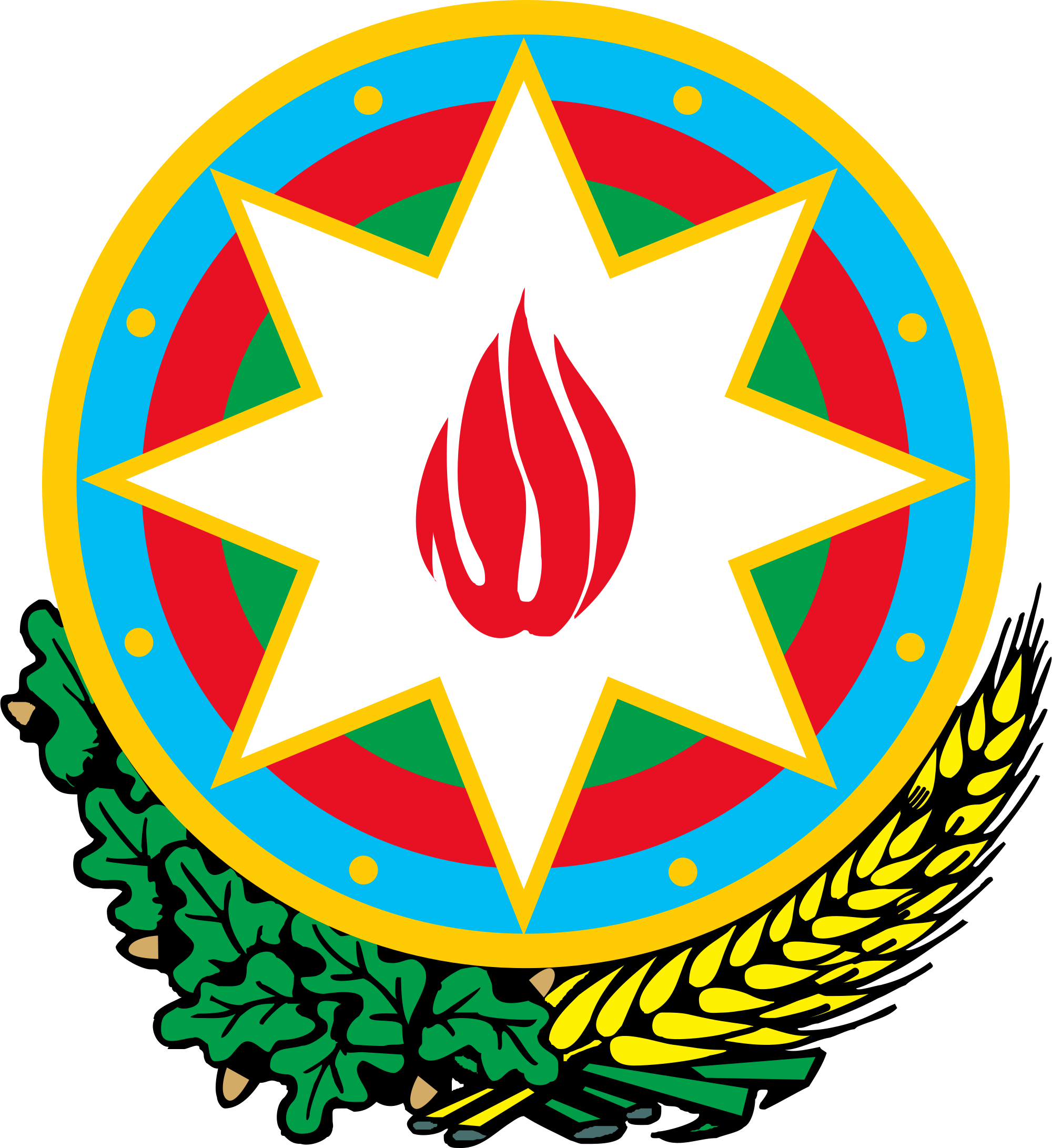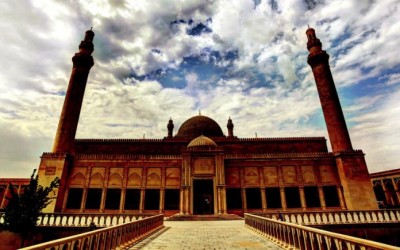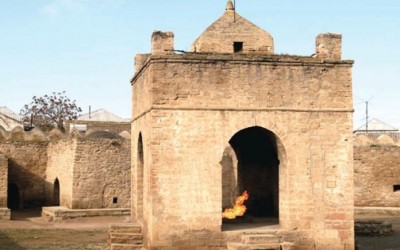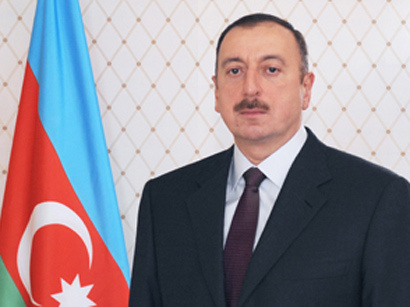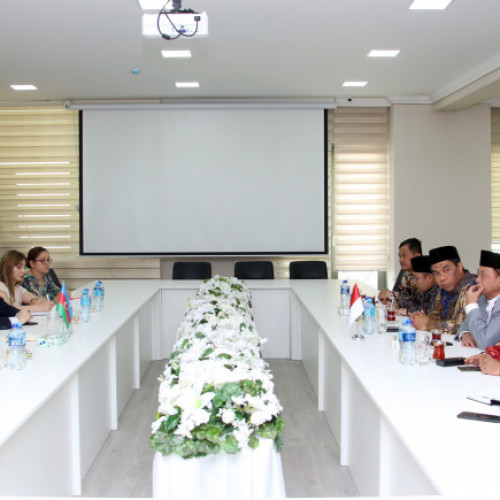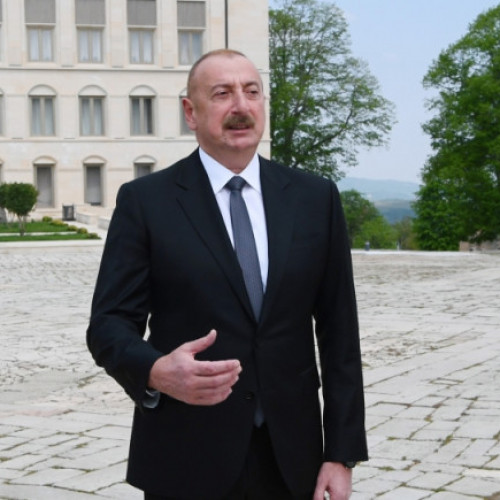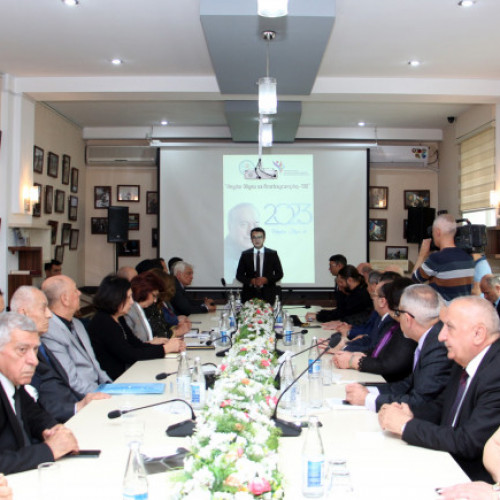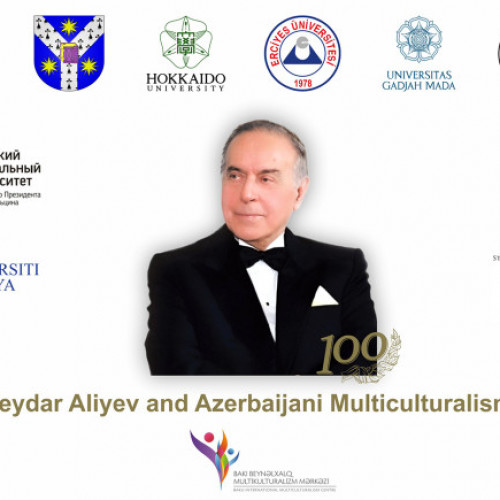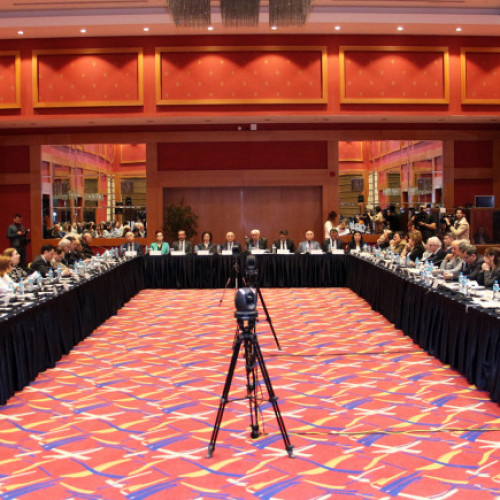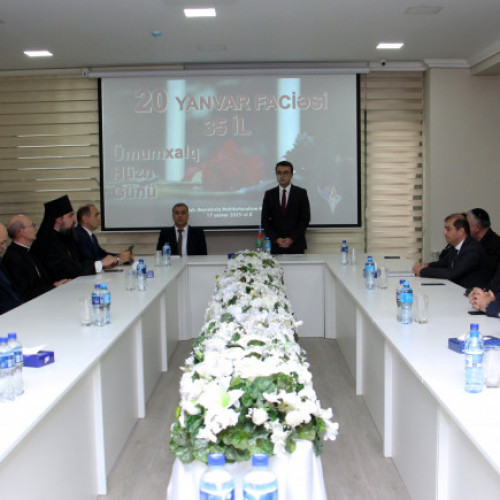Christianity in Azerbaijan
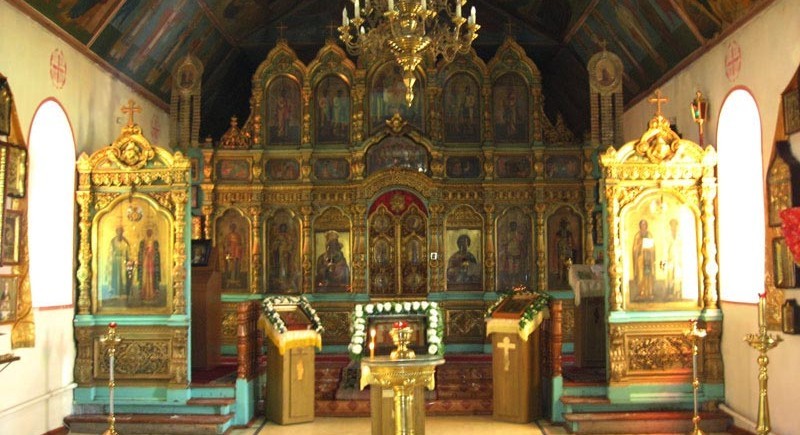
Christianity began to spread in Azerbaijan during the lifetime of the disciples of Jesus Christ. Apostles began to arrive in the ancient Azerbaijani state Caucasian Albania in order to propagate this religion. The propagation of Christianity in Caucasian Albania is associated with the names of Apostles Bartholomew and Thaddeus, as well as Elisha and Mar, students of Thaddeus. Elisha’s efforts led to the founding of the first Christian church of the Caucasus, which became famous as the “Mother of Eastern churches”, in the Kish village of the present-day district of Shaki. Later, Christian communities also emerged in other places of Caucasian Albania, and thus, the Albanian Apostolic Church was established.

Included in the group of ancient eastern churches, the Albanian Apostolic Church is considered to be one of the oldest churches not only in the Caucasus, but also in the whole Christian world. This church once enjoyed a dominant position in the territory of Azerbaijan. Urnair, the King of Caucasian Albania from the Arsacid dynasty, declared Christianity the state religion in 313, granting official church status to the Albanian Apostolic Church.
The Albanian Apostolic Church played an important role in the cultural development of Caucasian Albania. In particular, the period between the 4th and 7th centuries is regarded as the heyday of Albania’s Christian architecture. This period saw the construction of magnificent Albanian Christian temples such as the Amaras monastery (4th century), Kilsadag church (4th to 5th centuries), Mamrukh temple (4th to 5th centuries), Lakit temple (4th to 6th centuries), Gum basilica (4th to 5th centuries), Khudavang monastery complex (6th to 7th centuries), and the church complex in Mingachevir (4th to 7th centuries).
During the period of the Mihranid dynasty between the 5th and 7th centuries, the political and economic position of the Albanian Apostolic Church was strengthened and its powers were significantly expanded. Due to its apostolic origin, the Albanian Church already became autocephalous (i.e. independent) in 340.
After the collapse of Caucasian Albania and its incorporation into the Arab Caliphate in 705, the Albanian Apostolic Church entered a period of decline. However, during the reign of Prince Hasan Jalal (1215–1261) in the 13th century, the influence of the Albanian Apostolic Church increased. In 1240, Jalal built the magnificent Ganjasar temple. In 1511, the Ganjasar monastery turned into the seat of Albanian Catholicos and subsequently into the political center of the Albanian Princedom in Karabakh. After Hasan Jalal, a lot of religious figures from his lineage, served as spiritual leaders of the country and Catholicos Patriarchs of the Albanian Church.
With the Russian occupation of the territory of North Azerbaijan in the early 19th century, the Albanian Apostolic Church was permanently closed down, as the Czarist government started a mass relocation of Armenians, their loyal servants, from Iran and Turkey to North Azerbaijan. The colonial regime of Czarist Russia tried to strengthen its hold in the region with their help. Therefore, the Russian Empire chose to protect the interests of the Armenian population, as well as the Armenian Gregorian Church. Taking advantage of this opportunity, the Armenian Gregorian Church asked the Czarist government to permanently abolish the Albanian Catholicosate. As a result, the Albanian Catholicosate was abolished under the Decree of Russian Czar Nikolai I (reign: 1825-1855) rendered on March 11, 1836. Thus, a historical injustice was committed – the Albanian Church was merged with the Armenian Gregorian Church.
The enmity of the Armenian clergy towards the Albanian Apostolic Church did not end there. In 1909-1910, the Holy Synod of the Russian Empire allowed the Armenian priests to destroy the old archival documents of the eparchies. This decision resulted in the destruction, i.e. armenization and appropriation, of all historical documents belonging to the Albanian Apostolic Church. By destroying the historical documents of the Albanian Apostolic Church, the Armenian clergy wanted to permanently erase this ancient eastern church from the history and implemented their insidious plans for the future.
Armenians appropriated the rich tangible cultural heritage of Caucasian Albania through falsification, destroyed the ancient inscriptions on ancient Albanian temples and replaced them with inscriptions in the Grabar language, and changed the architectural design of Albanian churches. According to Academician Ramiz Mehdiyev, by destroying the archives of the Albanian church and abundant tangible examples of the Albanian history and culture, Armenians tried to prove that the Albanian state and the autocephalous Albanian church never existed and the Albanian lands originally belonged to Hays, i.e. Armenians.
The policy of gregorianization and armenization faced resistance from the local Christian population. Not wanting to worship under the leadership of Armenian priests, the Udi people, who followed the Albanian Apostolic Church, wrote a letter of protest to the Russian czar in 1867. In that letter, they stated their refusal to even come together in the ancient Albanian Christian temples placed at the disposal of Armenian Gregorian priests.
Armenians, who tried to tamper with and destroy everything that reminded of Caucasian Albania and the Albanian Apostolic Church, could not fully implement their insidious plans. The Udi people, who currently live in Gabala and Oghuz districts of Azerbaijan, have preserved the religious traditions of this ancient eastern church to this day. After the restoration of state independence by the Azerbaijani nation, two Albanian-Udi religious communities were registered by the state: the Albanian-Udi Christian religious community of the Republic of Azerbaijan and the Albanian-Udi Christian religious community of Oghuz city. Furthermore, on July 14, 2013, the tradition of baptism, which had been forgotten for more than 80 years, was revived in the Albanian-Udi religious community. On August 3, 2013, a ceremony was held with state support to celebrate the 10th anniversary of the revival of the Albanian-Udi church and the 1700th anniversary of Christianity’s adoption as the official religion in Caucasian Albania. It is also a reality that the Udi people living in our country are surrounded with full attention and care by the state of Azerbaijan.
The state of Azerbaijan carries out important work aimed at studying the ancient and rich history of Caucasian Albania, discovering the real scientific and historical truths, and exposing the Armenian falsifications. Because it is confirmed by undeniable historical facts that the only successor of the magnificent tangible cultural heritage of Caucasian Albania is Azerbaijanis.
Eastern Orthodox Christianity
The Russian Orthodox Church is the largest Christian confession in Azerbaijan by the number of adherents. The establishment of this church in our country dates back to the early 19th century, when representatives of Eastern Orthodox peoples such as Russians, Belarusians and Ukrainians began to settle in our country following the Russian occupation of North Azerbaijani lands. Of course, it was in the Czarist regime’s interests to spread Eastern Orthodoxy and to increase the number of Russian and, in general, Christian population in the Muslim-majority regions of the newly occupied lands, because the Russian Empire sought to strengthen its hold in the region through Christianization and russification. Eastern Orthodoxy was considered one of the main ideological pillars of the empire. The Russian Church acted as the protector of the Czarist regime’s interests in the regions.
As for the social background of the Russians who settled in our country in the 19th century, the early population of Russian Orthodox followers consisted mostly of the military, officials of the colonial administration and their family members. To meet their religious needs, military parishes were created in their areas of residence, including Baku, where only a mobile military church had initially operated.
Seeing that the Russians living in Baku needed a temple, lieutenant-general Nikolai Fedorovich Rtishev (1754-1835), the commander-in-chief of the Russian troops in the Caucasus, made an initiative to build Orthodox churches and, in 1815, the Russian Orthodox temple named “St. Nicholas the Miracle Worker of Myra” was erected next to the Maiden Tower with the donations of the city population. Later, people began to call this Russian temple “the old church” or “the first church”.
During the oil boom in the late 19th and early 20th centuries, a lot of specialists and workers of different nationalities began to arrive in Baku. There were many Russians among them. For instance, in 1893, Baku had a population of 106,467, of which 21,744 were Russian Orthodox followers. The Czarist administration constantly monitored the religious needs of the Russian population and supported the construction of numerous Orthodox churches in different cities of Azerbaijan. In 1893, there were 25 Orthodox facilities (six Orthodox churches, two chapels and 17 other auxiliary church buildings) in Baku only. In 1889-1899, the largest Russian Orthodox church of the South Caucasus was built in Baku. The foundation laying ceremony of this splendid temple erected in honor of Alexander Nevski was attended by Russian czar Alexander III (reign: 1881-1894) and his family.
After the forcible seizure of power in Azerbaijan by Bolsheviks on April 28, 1920, atheism was raised to the level of state ideology. Adherents of all religions, including Russian Orthodox followers, suffered from this policy of the Soviet government. For instance, the Alexander Nevski Cathedral (1936), the St. Nicholas the Miracle Worker Cathedral (1930s), the St. Bartholomew Church standing next to the Maiden Tower (1936) and other Russian temples were demolished.
After the restoration of state independence by the Azerbaijani nation, the freedom of religion and conscience was provided in our country. In particular, with National Leader Heydar Aliyev’s return to power, positive progress was made in the area of regulating the ethno-religious situation in our country. It suffices to note that the Baku and Caspian Eparchy of the Russian Orthodox Church (currently “the Baku and Azerbaijan Eparchy”), which was abolished during the Soviet era, was restored at the initiative of National Leader Heydar Aliyev. This is a good example of the National Leader’s attention and care to the ethnic and religious minorities. Furthermore, by order of Azerbaijani President Mr. Ilham Aliyev, the Orthodox Religious and Cultural Center of the Baku and Azerbaijan Eparchy of the Russian Orthodox Church was opened on November 15, 2013.
In addition to Russian Orthodox followers, Azerbaijan is also home to the adherents of the Georgian Orthodox Church. They reside mostly in the district of Gakh, which hosts four Georgian Orthodox temples: Saint George Georgian-Orthodox Church in Gakhingiloy village, Saint Nino Church in Alibayli village, Holy Sameba Church in Kotuklu village, and Saint Michael Church in Meshabash village. All these Georgian Orthodox temples were constructed at the end of the 19th century.
Catholicism
The history of this Christian denomination in North Azerbaijan starts from the early 14th century. In 1320, French monk Jordan of Severac visited Baku and other cities, and shortly afterwards, Franciscan Odoric of Pordenone visited our country. As a result, Catholic missions, monasteries and schools were established in Baku, Shamakhi, Ganja and Nakhchivan. Twelve Catholic monasteries were opened in Nakhchivan only. However, the outbreak of plague in 1346‑1353 and the military aggressions by Timur put an end to the activities of Catholic missions in the East, including North Azerbaijan.
With the establishment of the Safavid state in Azerbaijan, Catholicism entered the next stage of development in our country. Thanks to the high-level diplomatic relations between the Safavid Empire and the Holy See, Catholic missions revived in the region and different Catholic societies (orders) began to operate in our country. The following orders of Catholic monks operated in the Safavid state during the respective periods: Augustinians (1573-1747), Carmelites (1604-1775), Capuchins (1628-1765), Jesuits (1653-1760) and Dominicans (1677-1764). In addition, Polish Jesuit missions emerged in the region in 1680, with the first such mission being established in Ganja. In particular, Catholic clergy gained the opportunity to operate freely during the reigns of Shah Abbas I (1587-1629) and Shah Sultan Huseyn (1694‑1722).
During the period of Czarist Russia, the surge in the number of Catholic Poles in North Azerbaijan started the next stage of development of the Roman Catholic Church in our country. In the early 18th century, Polish soldiers forcibly serving in the Russian army arrived in North Azerbaijan and formed Polish military garrisons in Zagatala, Gusar and Baku. Catholic chapels (small churches) were erected at the deployment sites of these garrisons, where religious rites were led by chaplains (military priests).
The oil boom in Baku in the late 19th and early 20th centuries led to an increase in the number of Catholics. There were doctors, pharmacists, engineers, architects and other professionals among them. The Catholics immigrants of Baku were mostly of Polish descent. In 1916, the number of the members of the Catholic Church reached 2,550. In 1903, Catholics founded the Roman Catholic Charity Society and the Open House Polish Catholic Society in Baku. In the same year, they built the Holy Cross Church in the city cemetery. In 1904, a one-class four‑year school of the Catholic parish was opened. However, the most significant event for the Catholic community took place in 1912, when a magnificent Catholic temple was opened in Baku in honor of Mother Mary. This Gothic-style church could accommodate 1,200 worshippers at a time. During the Soviet era, this church was demolished (in 1931 or 1934) and the Catholic community was eliminated.
After Azerbaijan’s restoration of state independence, the Catholic community was able to resume its activities. On April 2, 1999, the Roman Catholic religious community of Baku was registered by the state. Also, by order of National Leader Heydar Aliyev, an area was allocated for the construction of a Catholic church in Baku. Consequently, a Catholic church was erected in honor of Mother Mary in the most attractive part of the country’s capital in 2007. And in 2011, the religious organization Apostolic Prefecture of the Catholic Church in the Republic of Azerbaijan was registered by the state.
In our country, Catholicism comes after Orthodoxy and Protestantism by the number of followers. Despite its small size, the Catholic community in our country takes an active part in public life and engages in charitable activities. A homeless shelter named after Mother Teresa, the Mary Education Center and other charitable facilities operate under the Apostolic Prefecture of the Catholic Church in the Republic of Azerbaijan.
Currently, there are eight places of worship (five churches, two chapels and one prayer house) administered by the Baku and Azerbaijan Eparchy. Four of them are located in Baku, and the rest are situated in Ganja, Sumgayit, Khachmaz and Lankaran.
Protestantism
Protestantism began to spread in Azerbaijan during the period of Czarist Russia.
Lutheranism and Pietism are the first Protestant movements to spread in Azerbaijan. In 1819, Württemberg Separatists founded the first German settlements called Elenendorf (present-day Goygol city) and Annefeld (present-day Shamkir) in our country. In the subsequent years, Württemberg Separatists established six more German colonies in our country.
The Basel Evangelical Missionary Society also contributed to the spread of Lutheranism in the Caucasus, including North Azerbaijan. In 1820s, missionaries of this Society facilitated the strengthening of Lutheranism in the region by opening a missionary school and a publisher of Christian literature in Shusha. Furthermore, protestant communities of Baptists and the Seventh‑day Adventist Church were formed in different regions of North Azerbaijan during the period of Czarist Russia.
Faced with persecution and oppression during the Soviet period, Protestants gained the opportunity to freely operate after Azerbaijan’s restoration of state independence. Currently, Protestantism is represented by different branches in our country. The following are the protestant communities registered in Azerbaijan: “New Life Christian Bible” religious community, Baku religious community of Savior Evangelical Lutherans, “Word of Life” Christian religious community, “Word of Life - 2” Christian religious community of Sumgayit, “Agape” religious community of Baku Evangelical Christian Baptists, “Seventh-day Adventists” religious community of Narimanov district of Baku, “Seventh-day Adventists of Ganja city” Christian religious community, “Vineyard Azerbaijan” Christian religious community, and “Alov” (Flame) Christian religious community of Baku.
Spiritual Christianity
Spiritual Christianity is a collective name for Russian sects, which originated in a rural environment in the Russian Empire in the 17th to 18th centuries, opposed the clergy and religious rites of the Russian Orthodox Church, and call for social equality, Christian fraternity, a return to the lifestyle of early Christians, and worship of God “in spirit and truth”.
Molokans were the first Spiritual Christians to settle in our country. Part of them were judicially exiled to the Caucasus, including Azerbaijan, by the Czarist government, while another part voluntarily settled in the Caucasus to welcome the second coming of Jesus Christ. In Azerbaijan, the first group of Molokans settled in Varanda district of Karabakh region in 1832.

Later, Molokan villages appeared in different parts of country in 1830s and 1840s.
Currently, there are four registered Molokan religious communities in Azerbaijan: “Molokan Spiritual Christian” religious community of Baku, “Molokan Spiritual Christian” religious community of Sumgayit city, “Molokan Spiritual Christian” religious community of Hilmilli village of Gobustan district, and “Molokan Spiritual Christian” religious community of Ivanovka village of Ismayilli district.
As for Dukhobors, another branch of Spiritual Christianity, it should be firstly noted that the adherents of this sect settled in Azerbaijan in 1844 and founded Slavyanka village. Located in Gadabay district, this village is the only Dukhobor settlement in our country.

